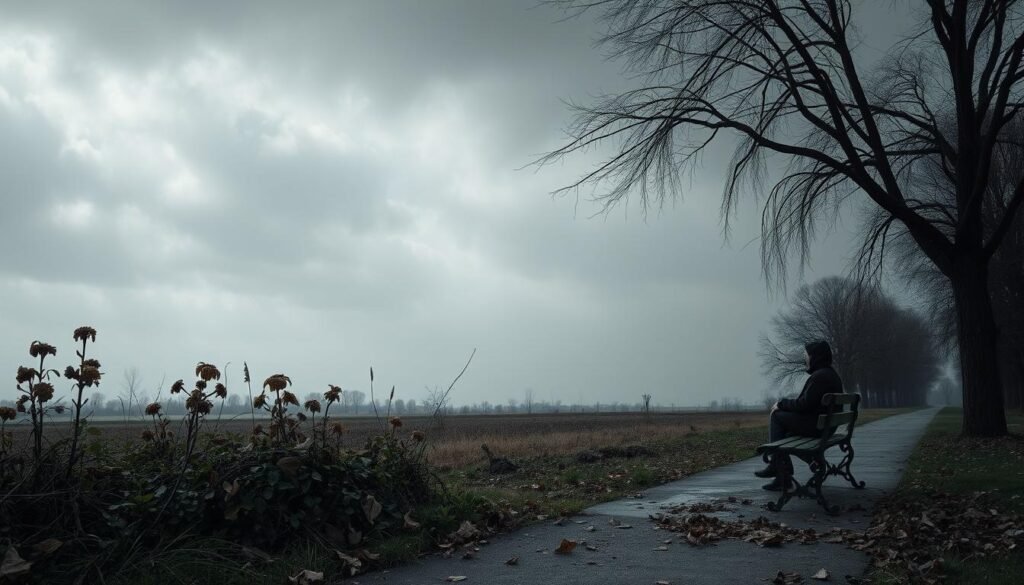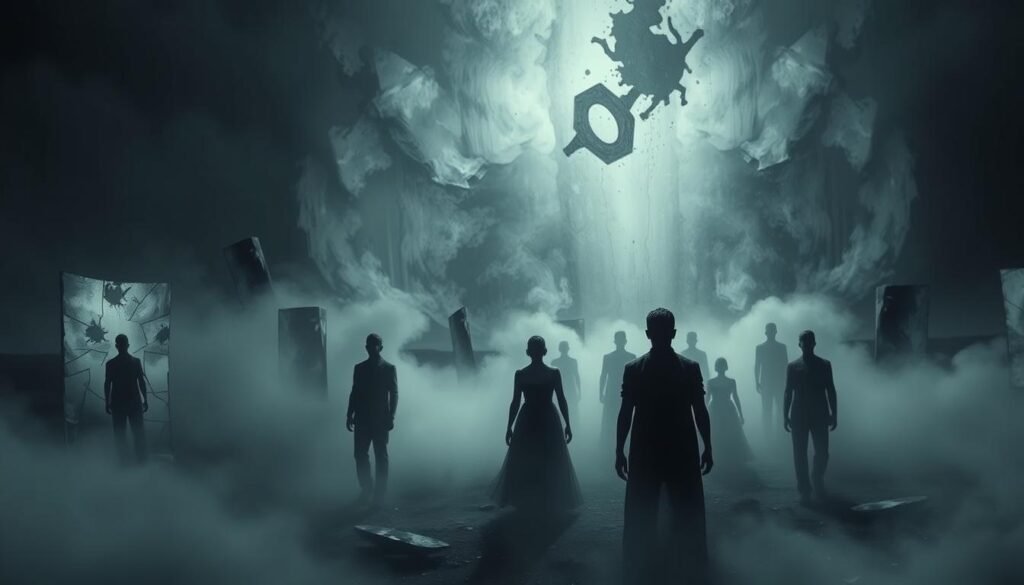Nearly 1 in 5 adults in the United States face mental illness annually, with depression being a common issue. This fact emphasizes the need to understand the various types of depression. Depression comes in different forms, such as major depressive disorder and bipolar disorder. Recognizing these varieties helps in creating better treatment plans and discussions.
Diving into the different kinds of depression reveals a complex web of symptoms, causes, and treatments. The crippling sadness of major depressive disorder and the extreme mood swings of bipolar disorder need distinct recognition for healing. The National Institute of Mental Health underscores the importance of professional help for those facing these symptoms.
Key Takeaways
- 1 in 5 adults in the U.S. experience mental illness each year.
- Understanding different types of depression aids in treatment.
- Major depressive disorder and bipolar disorder are key depression types.
- Professional help is vital for managing depression symptoms.
- Recognizing risk factors can improve treatment effectiveness.
What is Depression?
Depression is a common but serious mood disorder. It greatly changes how people feel, think, and handle daily life. The definition of depression covers many symptoms, from mild to severe. They deeply affect a person’s mental health.
This isn’t just about feeling sad for a short time. It’s a long-term struggle that can mess with someone’s feelings and what they can do each day. Mental health experts say depression makes daily tasks hard. People with it might have trouble keeping up relationships, doing well at work, or enjoying hobbies. By understanding depression, we can better treat it and fight its stigma.
Many studies show we need good intervention and awareness to fight depression’s effects. Knowing the definition of depression and its signs helps people seek early help. This leads to a better grasp of mental health issues.
Understanding the Different Types of Depression
It’s vital to know the different types of depression for effective help. Each kind has unique signs, but common symptoms are often seen. By recognizing these variations, diagnosis and care become more accurate.
Definition and Overview
Depression includes various disorders with specific features. Major depressive disorder (MDD) involves deep sadness and despair that lasts weeks or more. On the other hand, persistent depressive disorder means long-term depression, lasting at least two years. Both need careful assessment for the right approach. Find more details at essential information about types of depression.
Common Symptoms of Depression
Depression symptoms vary and affect people differently. Some common ones are:
- Persistent feelings of sadness or emptiness
- Loss of interest in activities once enjoyed
- Appetite or weight changes
- Sleep problems, like insomnia or sleeping too much
- Feeling tired all the time
- Struggle to focus or decide on things
Both major and persistent depressive disorders have these symptoms. They can really impact how someone lives each day. It’s crucial to understand these signs for getting the right help.
Major Depressive Disorder (MDD)
Major Depressive Disorder, or MDD, is a severe mental health issue. It’s marked by ongoing sadness and a lack of interest in things once enjoyed. It’s important to recognize the signs of MDD in oneself or others.
Symptoms and Diagnosis
The effects of major depressive disorder can greatly disrupt daily life. Key symptoms include:
- Persistent sadness or low mood
- Fatigue and low energy levels
- Changes in appetite or weight
- Difficulty concentrating or making decisions
- Sleep disturbances, such as insomnia or oversleeping
- Feelings of worthlessness or excessive guilt
Diagnosing MDD often involves the DSM-5 criteria used by healthcare experts. This ensures a detailed evaluation, leading to appropriate treatment plans.
Treatment Options
Treating major depression usually involves multiple strategies. These are customized to fit the person’s needs. Treatment might include:
- Psychotherapy: This can offer coping methods through different therapy types like cognitive-behavioral therapy (CBT).
- Medications: Antidepressants might be given to balance mood.
- Lifestyle Changes: Exercise, diet, and mindfulness can help ease symptoms.
Getting professional help is crucial for anyone dealing with MDD. A careful diagnosis is vital. For more on depression, check out this resource.
| Treatment Method | Description | Effectiveness |
|---|---|---|
| Psychotherapy | Cognitive-behavioral therapy to modify negative thinking patterns. | Highly effective for many individuals. |
| Medications | Antidepressants to help manage chemical imbalances. | Varies; important to monitor side effects. |
| Lifestyle Changes | Incorporating exercise and nutrition for overall well-being. | Supportive and useful alongside other treatments. |
Persistent Depressive Disorder
Persistent depressive disorder, known as dysthymia, lasts for at least two years. It’s a chronic form of depression. It’s similar to major depressive disorder but less intense. Understanding this can help recognize the struggles faced by individuals.
How it Differs from Major Depression
Dysthymia is a constant state, unlike major depressive disorder’s episodic nature. Those with dysthymia have a steady low mood that affects them deeply. Here’s how they differ:
| Feature | Persistent Depressive Disorder (Dysthymia) | Major Depressive Disorder (MDD) |
|---|---|---|
| Duration | At least 2 years | Episodes lasting 2 weeks or more |
| Severity | Less severe, but persistent | Can be more intense |
| Mood Variation | Generally stable, low mood | Fluctuates between low and high |
| Response to Treatment | May require longer-term strategies | Often responsive to short-term interventions |
Long-term Effects
Persistent depressive disorder has serious long-term depression effects. It can lead to problems in different parts of life, like:
- Impaired daily functioning
- Struggles in personal relationships
- Decreased overall quality of life
Recognizing these effects shows why early diagnosis is crucial. Early treatment can improve life quality and help people live more fully.

Bipolar Disorder
Bipolar disorder is a mental health condition marked by extreme mood swings. These swings can greatly affect someone’s life and well-being. Understanding these swings is key for managing them. The mood episodes include emotional highs like mania or hypomania. They are followed by lows that may cause depression. Recognizing these changes is crucial. They can lead to more severe symptoms if ignored.
Understanding Mood Swings
Mood swings in bipolar disorder can be intense and last different times. During mania, a person might have high energy, feel overly happy, or easily irritated. These states can disrupt normal life. The person may take risks due to feeling overly confident. On the other hand, depressive phases bring sadness, tiredness, and loss of interest in hobbies. Knowing what triggers these moods can help manage them better.
Types of Bipolar Disorder
There are mainly three types of bipolar disorder: Bipolar I, Bipolar II, and Cyclothymic Disorder. Each has its own mood swing patterns and severity levels:
- Bipolar I: Comes with serious mania and often major depression.
- Bipolar II: Has depressive and hypomanic episodes, but no extreme mania like in Bipolar I.
- Cyclothymic Disorder: Includes milder symptoms of hypomania and depression. These last at least two years, or one year in kids and teens. They are less severe than in Bipolar I or II.
Knowing the differences in bipolar disorder types aids in finding the best treatment plans. For more in-depth info, check out this detailed guide for useful insights.
Seasonal Affective Disorder (SAD)
Seasonal Affective Disorder (SAD) is a type of depression that shows up in certain seasons. It usually happens in the fall and winter. This is because there isn’t as much sunlight, which can make people feel moody or have less energy. Folks might start to feel signs of SAD during these times.
Some common signs are feeling really tired, sleeping more or having trouble sleeping, keeping to oneself, and not being able to concentrate. These symptoms are a big deal. They show us that someone might be struggling with SAD.
- Fatigue and decreased energy
- Increased sleep duration or changes in sleep patterns
- Social withdrawal and isolation
- Difficulties in concentration or focus
To deal with seasonal affective disorder, it’s all about handling the lack of sunlight. There are different ways to do this. Each method aims to make people feel better during the tough months.
- Light therapy – using a special light box that mimics sunlight
- Medications – like antidepressants, if a doctor thinks it’s needed
- Lifestyle changes – doing things like exercise and eating right
If you notice the signs of winter depression, it’s important to act. Knowing what’s happening means you can get help and work on feeling better. Remember, taking action can make a big difference in your mental health.
Postpartum Depression
Postpartum depression is a serious condition that many face after having a baby. It happens due to hormonal, physical, emotional, and social changes. Knowing the causes of postpartum depression helps spot those at risk and get them help fast.
Causes and Risk Factors
Several factors lead to postpartum depression:
- Hormonal changes after giving birth
- Adjusting emotionally to being a mom
- Stress from taking care of a baby
Some factors make this condition more likely. These include a personal or family history of depression, not having enough support, and problems during pregnancy. They can all play a part in triggering postpartum depression.
Treatment Approaches
Finding the right treatment for postpartum depression matters a lot. Some helpful treatments are:
- Counseling and therapy for support and strategies to cope
- Support groups for community feeling
- Medicines, if needed, with a doctor’s advice
Getting help early from healthcare workers can make a big difference. It helps the mother and baby a lot during this tough time. For deeper insights, one can look at postpartum depression resources.
| Factor | Description |
|---|---|
| Hormonal Changes | Hormones changing rapidly after birth can affect mood. |
| Emotional Adjustment | Becoming a mom involves complex emotional shifts. |
| Social Support | Lacking support can make one feel very alone. |
| Pregnancy Complications | Difficulties during pregnancy can increase stress and worry. |
Psychotic Depression
Psychotic depression is a serious and complex kind of depression, with psychotic symptoms. People with it might face scary delusions or hallucinations. Knowing the symptoms is key for early help and effective treatment.

The signs of psychotic depression can be similar to major depression, making things harder. People often feel very sad, worthless, and have no motivation. They might hear voices or see things that aren’t there. Or, they could strongly believe in things that aren’t true.
Treating psychotic depression usually means using antidepressants and antipsychotic drugs together. This way, both the depression and psychotic parts can be helped. It’s very important to get help from mental health experts. They make sure the treatment fits the person’s needs.
| Type of Treatment | Description | Common Medications |
|---|---|---|
| Antidepressants | Medications that alleviate depressive symptoms | SSRIs, SNRIs |
| Antipsychotics | Medications that reduce psychotic symptoms | Risperidone, Olanzapine |
| Therapy | Psychotherapeutic approaches to support recovery | Cognitive Behavioral Therapy (CBT), Supportive Therapy |
Learning about psychotic depression, spotting its signs, and knowing the treatment choices helps with recovery. It leads to a better life for those dealing with it.
Situational Depression
Situational depression often kicks in after big changes or losses in life. It can happen because of events like losing a job, going through a breakup, or dealing with big changes. Knowing why it happens helps us support those going through hard times.
Causes and Triggers
Many things can trigger situational depression. Important triggers include:
- Big life changes, like moving to a new city
- Losing someone close
- Problems in a relationship or a divorce
- Money troubles or losing a job
Events like these can make someone feel overwhelmed, sad, and hopeless. Seeing and understanding these triggers is important on the path to getting better.
Management Strategies
There are many ways to manage situational depression. It’s important to:
- Therapy: Talking to a therapist or counselor can help you understand your feelings and find ways to cope.
- Coping Mechanisms: Using mindfulness and writing in a journal can make you stronger emotionally.
- Support Networks: Connecting with friends, family, or groups can give comfort and support when you need it most.
Using these strategies in your life can help you work through your feelings in a positive way.
| Trigger | Common Symptoms | Management Strategies |
|---|---|---|
| Job Loss | Sadness, anxiety, lack of motivation | Counseling, job search support groups |
| Relationship Breakdown | Feelings of isolation, crying spells, hopelessness | Therapy, social activities, open communication with friends |
| Health Issues | Fatigue, frustration, irritability | Medical support, therapy, stress management techniques |
Atypical Depression
Atypical depression presents its own challenges, unlike other depression forms. Those affected can feel mood changes due to happy events. This is different from more constant types of depression. A key symptom of atypical depression is an increased appetite, which may lead to weight gain.
Symptoms of atypical depression also include trouble sleeping, like sleeping too much, and being very sensitive in relationships. This makes socializing harder. People may feel more rejected, hurting their relationships more.
Targeted treatment is needed for atypical depression. This often involves certain antidepressants, like monoamine oxidase inhibitors (MAOIs). Different medication classes have shown good results. Cognitive behavioral therapy (CBT) is also crucial in treatment.
| Symptoms | Potential Treatments |
|---|---|
| Mood reactivity | Monoamine oxidase inhibitors (MAOIs) |
| Increased appetite | Selective serotonin reuptake inhibitors (SSRIs) |
| Excessive sleep | Cognitive behavioral therapy (CBT) |
| Interpersonal sensitivity | Interpersonal therapy (IPT) |
Why Understanding the Different Types of Depression is Important
Knowing the different types of depression matters a lot for mental health. It’s key for creating empathy and giving the right care. Knowing this lets people spot symptoms early. This can help them get help sooner and get better faster.
Talking more about depression helps fight off bad stereotypes. It lowers the shame people might feel about mental health problems. Knowing the small differences in depression types makes everyone more supportive. It leads to open talks, better help, and more support in the community.
When someone is depressed, they need care that fits just right for them. The kind of depression they have can change what kind of care they need. Understanding this helps their loved ones support them better. This makes it easier for everyone to help each other out.
Conclusion
Exploring different types of depression shows us how complex this mental health issue is. There are various forms like Major Depressive Disorder, Bipolar Disorder, and Seasonal Affective Disorder. Each has its own challenges and symptoms. It’s important to know about these types to recognize signs and help those in need.
Education on depression types can make us all more understanding. It can reduce stigma and encourage people to seek help without fearing judgment. When we’re informed, we can support each other better. This creates a community where healing is possible.
Understanding depression is the first step to mental well-being. As we learn more, we create a kinder society. A society that supports recovery and accepts those facing mental health challenges.